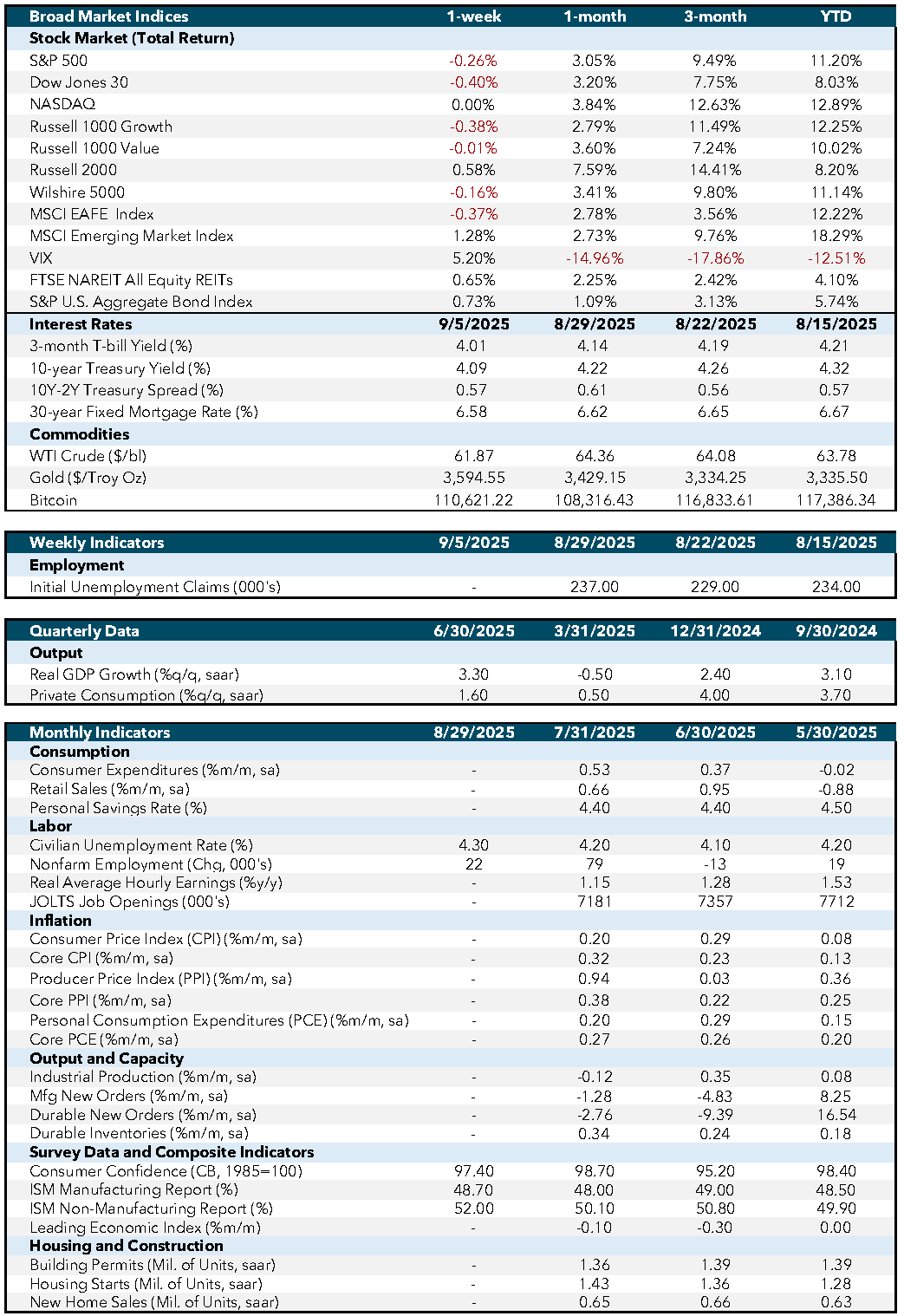
Market Commentary | September 8th, 2025
Weekly Market Commentary
September 8th, 2025
Week in Review…
Last week was pivotal for labor market data, with several key reports shaping investor sentiment. Markets also digested fresh survey data as participants assessed the economic outlook.
Labor Market Insights
On Wednesday, the July Job Openings and Labor Turnover Survey (JOLTS) report offered a closer look at labor demand. Headline job openings came in below expectations, continuing the trend of softness in the job market. However, voluntary quits (a proxy for worker confidence), held steady at 3.2 million (2.0%). Notably, quits increased in professional and business services, signaling resilience in those sectors, while declines in construction and transportation, warehousing, and utilities pointed to weakness elsewhere.
Friday brought further disappointment as August Nonfarm Payrolls rose by just 22,000, well below the consensus estimate of 75,000 and the prior month’s 79,000. The unemployment rate ticked up to 4.3%, its highest level since July 2024.
Productivity and Cost Trends
There were some bright spots. Q2 annualized Nonfarm Productivity exceeded expectations, suggesting improved labor efficiency, which is an encouraging sign for wage growth without fueling inflation. Additionally, quarter-over-quarter Unit Labor Costs rose only 1.0%, below the 1.2% forecast and sharply lower than the prior quarter’s 6.9%. As Unit Labor Costs are a leading indicator of inflation, markets will watch closely to see if this trend persists.
Sentiment and Survey Data
Markets also received key sentiment indicators from S&P Global and the Institute for Supply Management (ISM). S&P Global’s Manufacturing and Services Purchasing Managers’ Indices (PMIs) came in below expectations but remained above 50, signaling continued expansion, albeit at a slower pace than anticipated. ISM data painted a mixed picture: Manufacturing stayed in contraction, while Services remained in expansion. Two notable ISM subcomponents were Prices and Unemployment. Price pressures eased across both sectors, while employment sentiment weakened, reinforcing concerns about labor market softness.
Week Ahead…

If last week’s theme was employment, this week’s focus shifts squarely to inflation. Investors will digest key price data for both producers and consumers, inflation expectations, and several important bond auctions.
Inflation Data in Focus
On Wednesday the U.S. Bureau of Labor Statistics will release headline and core Producer Price Index (PPI) data, offering insight into input costs for raw, semi-finished, and finished goods and services. Investors will be watching for signs of tariff-related cost pressures and whether businesses are absorbing these costs or passing them on to consumers.
Thursday the spotlight shifts to headline and core Consumer Price Index (CPI) data. While PPI shows upstream price trends, CPI will reveal how much of those costs have filtered through to consumers. Core CPI in particular will be closely monitored as a gauge of underlying inflationary pressures.
Consumer Sentiment and Inflation Expectations
On Friday, the University of Michigan will release its September preliminary survey, including 1-year and 5-year inflation expectations, as well as consumer sentiment and expectations. These metrics are critical because consumer confidence often influences spending behavior, a key driver of economic growth.
Quick Hitters
Treasury Auctions: 3-, 10-, and 30-year bond auctions will take place. The 10-year note remains a key benchmark for mortgage rates and overall borrowing costs, and demand at these auctions will provide insight into investor appetite for U.S. debt.
Energy Outlook: Monthly reports from the International Energy Agency (IEA) and OPEC will be released. While energy prices are excluded from Core CPI, they remain a significant factor for consumers and can influence headline inflation and consumer sentiment.
Economic Indicators:
- CPI: Consumer Price Index measures the average change in prices paid by consumers for goods and services over time. Source: Bureau of Labor Statistics.
- Core CPI: Core Consumer Price Index excludes food and energy prices to provide a clearer picture of long-term inflation trends. Source: Bureau of Labor Statistics.
- PPI: Producer Price Index measures the average change in selling prices received by domestic producers for their output. Source: Bureau of Labor Statistics.
- Core PPI: Core Producer Price Index excludes food and energy prices to provide a clearer picture of long-term inflation trends. Source: Bureau of Labor Statistics.
- PCE: Personal Consumption Expenditures measure the average change in prices paid by consumers for goods and services. Source: Bureau of Economic Analysis.
- Core PCE: Core Personal Consumption Expenditures exclude food and energy prices to provide a clearer picture of long-term inflation trends. Source: Bureau of Economic Analysis.
- Industrial Production: Measures the output of the industrial sector, including manufacturing, mining, and utilities. Source: Federal Reserve.
- Mfg New Orders: Measures the value of new orders placed with manufacturers for durable and non-durable goods. Source: Census Bureau.
- Durable New Orders: Measures the value of new orders placed with manufacturers of durable goods. Source: Census Bureau.
- Durable Inventories: Measures the value of inventories held by manufacturers for durable goods. Source: Census Bureau.
- Consumer Confidence (CB, 1985=100): Measures the degree of optimism that consumers feel about the overall state of the economy and their personal financial situation. Source: Conference Board.
- ISM Manufacturing Report: Measures the economic health of the manufacturing sector based on surveys of purchasing managers. Source: Institute for Supply Management.
- ISM Non-Manufacturing Report: Measures the economic health of the non-manufacturing sector based on surveys of purchasing managers. Source: Institute for Supply Management.
- Leading Economic Index: Measures overall economic activity and predicts future economic trends. Source: Conference Board.
- Building Permits (Mil. of Units, saar): Measures the number of new residential building permits issued. Source: Census Bureau.
- Housing Starts (Mil. of Units, saar): Measures the number of new residential construction projects that have begun. Source: Census Bureau.
- New Home Sales (Mil. of Units, saar): Measures the number of newly constructed homes sold. Source: Census Bureau.
- SA: Seasonally adjusted.
- SAAR: Seasonally adjusted annual rate.
Market Indices & Indicators:
- S&P 500: A market-capitalization-weighted index of 500 leading publicly traded companies in the U.S., widely regarded as one of the best gauges of large U.S. stocks and the stock market overall.
- Dow Jones 30: Also known as the Dow Jones Industrial Average, it tracks the share price performance of 30 large, publicly traded U.S. companies, serving as a barometer of the stock market and economy.
- NASDAQ: The world’s first electronic stock exchange, primarily listing technology giants and operating 29 markets globally.
- Russell 1000 Growth: Measures the performance of large-cap growth segment of the U.S. equity universe, including companies with higher price-to-book ratios and growth metrics.
- Russell 1000 Value: Measures the performance of large-cap value segment of the U.S. equity universe, including companies with lower price-to-book ratios and growth metrics.
- Russell 2000: A market index composed of 2,000 small-cap companies, widely used as a benchmark for small-cap mutual funds.
- Wilshire 5000: A market-capitalization-weighted index capturing the performance of all American stocks actively traded in the U.S., representing the broadest measure of the U.S. stock market.
- MSCI EAFE Index: An equity index capturing large and mid-cap representation across developed markets countries around the world, excluding the U.S. and Canada.
- MSCI Emerging Market Index: Captures large and mid-cap representation across emerging markets countries, covering approximately 85% of the free float-adjusted market capitalization in each country.
- VIX: The CBOE Volatility Index measures the market’s expectations for volatility over the coming 30 days, often referred to as the “fear gauge.”
- FTSE NAREIT All Equity REITs: Measures the performance of all publicly traded equity real estate investment trusts (REITs) listed in the U.S., excluding mortgage REITs.
- S&P U.S. Aggregate Bond Index: Represents the performance of the U.S. investment-grade bond market, including government, corporate, mortgage-backed, and asset-backed securities.
- 3-Month T-bill Yield (%): The yield on U.S. Treasury bills with a maturity of three months, reflecting short-term interest rates.
- 10-Year Treasury Yield (%): The yield on U.S. Treasury bonds with a maturity of ten years, reflecting long-term interest rates.
- 10Y-2Y Treasury Spread (%): The difference between the yields on 10-year and 2-year U.S. Treasury bonds, often used as an indicator of economic expectations.
- WTI Crude ($/bl): The price per barrel of West Texas Intermediate crude oil, a benchmark for U.S. oil prices.
- Gold ($/Troy Oz): The price per troy ounce of gold, a standard measure for gold prices.
- Bitcoin: A decentralized digital currency without a central bank or single administrator, which can be sent from user to user on the peer-to-peer bitcoin network.
This content was developed by Cambridge from sources believed to be reliable. This content is provided for informational purposes only and should not be construed or acted upon as individualized investment advice. It should not be considered a recommendation or solicitation. Information is subject to change. Any forward-looking statements are based on assumptions, may not materialize, and are subject to revision without notice. The information in this material is not intended as tax or legal advice.
Investing involves risk. Depending on the different types of investments there may be varying degrees of risk. Socially responsible investing does not guarantee any amount of success. Clients and prospective clients should be prepared to bear investment loss including loss of original principal. Indices mentioned are unmanaged and cannot be invested into directly. Past performance is not a guarantee of future results.
The Dow Jones Industrial Average (DJIA) is a price-weighted index composed of 30 widely traded blue-chip U.S. common stocks. The S&P 500 is a market-cap weighted index composed of the common stocks of 500 leading companies in leading industries of the U.S. economy. The NASDAQ Composite Index is a market-value weighted index of all common stocks listed on the NASDAQ stock exchange.
Securities offered through Cambridge Investment Research, Inc., a broker-dealer, member FINRA/SIPC, and investment advisory services offered through Cambridge Investment Research Advisors, Inc., a Registered Investment Adviser. Both are wholly-owned subsidiaries of Cambridge Investment Group, Inc. V.CIR.0925
















